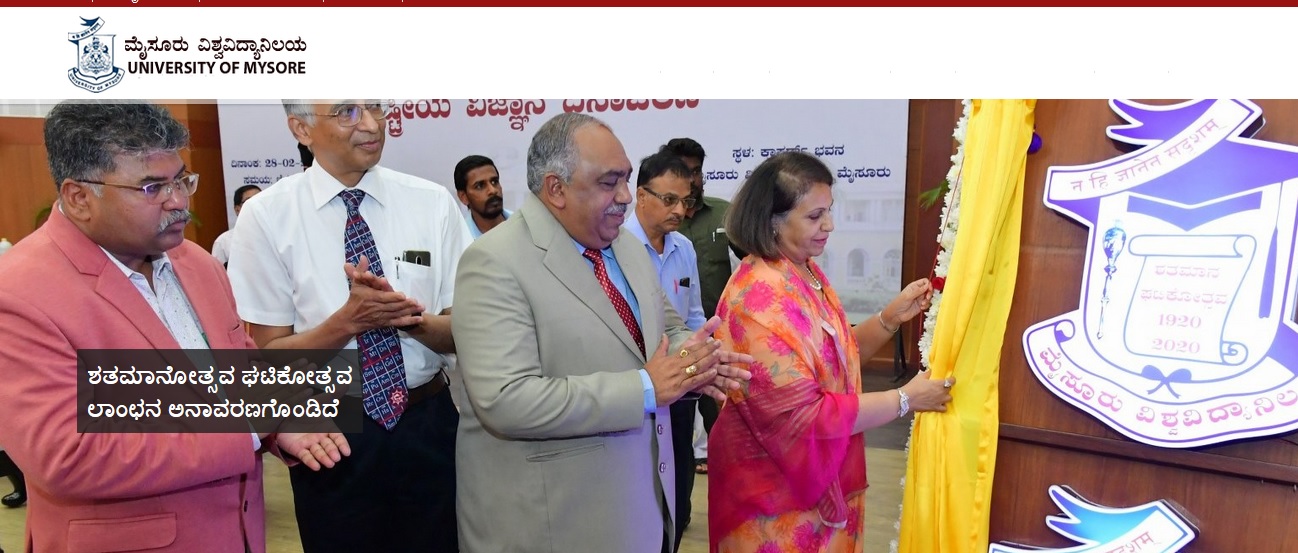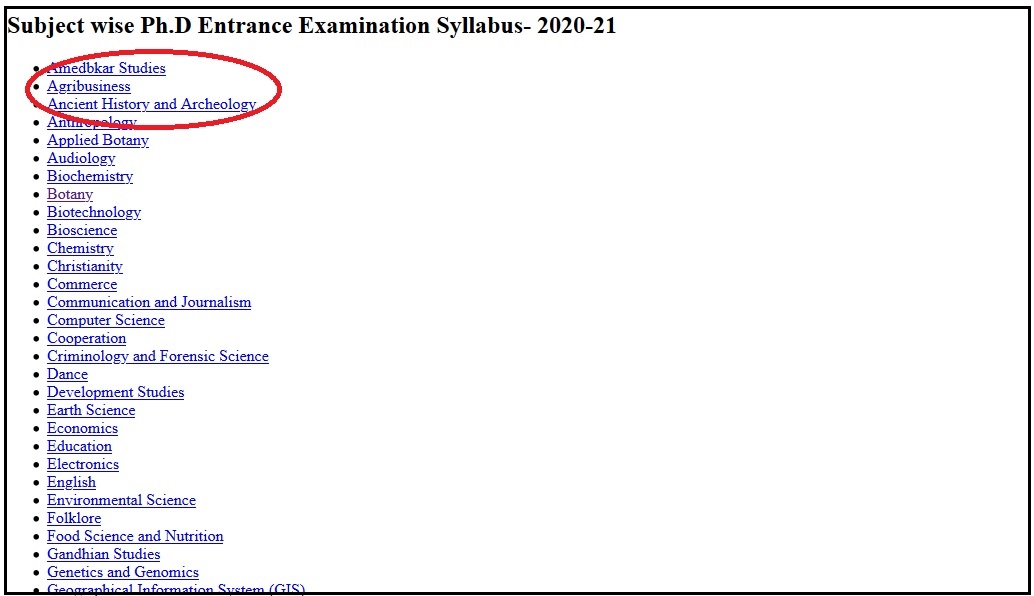University of Mysore Ph.D Entrance Exam Syllabus 2020-21 : uni-mysore.ac.in
Organisation : University of Mysore
Exam Name : Ph.D Entrance Examination 2020-21
Service Name : Ph.D Entrance Exam Syllabus 2020-21
Website : https://uni-mysore.ac.in/phdsyllabus-2020/
University of Mysore Ph.D Syllabus
University of Mysore, Ph.D Entrance Examination Syllabus 2020-21

How To Download Syllabus?
Just follow the simple steps mentioned below to download the syllabus of Ph.D Entrance Examination 2020-21.
Steps:
Step-1 : Go to the link https://uni-mysore.ac.in/phdsyllabus-2020/
Step-2 : Click on the “Subject” link
Step-3 : Download Syllabus

Ph.D Entrance Syllabus
Botany:
Unit 1:
Microbial diversity, Concept, Significance and important contributions. General characteristics, distribution, classification, structure, reproduction, evolutionary trends and importance of viruses, mycoplasmas, bacteria, fungi and algae. Brief account of viroid’s and prions.
Unit 2:
General characteristics, distribution, classification, structure, reproduction, evolutionary trends and economic importance of Bryophytes, Pteridophytes and Gymnosperms. Structure and evolution of gametophytes and sporophytes. Stelar evolution ptreidophytes. Heterospory and seed habit. Brief account of fossil bryophytes, fossil pteridophytes and fossil gymnosperms.
Unit 3:
History and scope of Taxonomy, Major and minor categories of classification, Nomenclature, ICBN. Salient features, morphological peculiarities, systematic position and affinities of Magnoliaceae, Casuarinaceae, Aizoaceace, Polygonaceae, Dioscoreaceae, Podostemaceae, Loranthaceae, Santalaceae, Alismataceae, Orchidaceae, Burmaniaceae, Arecaceae. Herbarium and importance, IUCN. Economic importance of cereals, pulses, oil yielding crops, fiber yielding crops, spices, beverages and forest products. Ethno botany and IPR, Medicinal plants and their importance.
Unit 4:
Reproductive Biology of Angiosperms: Historical development, microsporogenesis, megasporogenesis, fertilization, endosperm and embryo development, polyembryony and apomixis, experimental embryology. Plant morphogenesis and tissue culture: History of Morphogenesis, Totipotency, plant growth and development, polarity, photo morphogenesis, cellular basis, relative and abnormal growth, differentiation and regeneration.
History of tissue culture and importance, methodology and applications of embryo, endosperm and meristematic tip, anther, protoplast and suspension culture, micro propagation, secondary metabolite production.
Unit 5:
Plant anatomy: Structural diversity of leaf, stem and root, simple tissues and their functions, xylem and phloem, vascular cambium, secretary cells. Classification and cytological characteristics of meristems, secondary growth, ecological anatomy, nodal anatomy, seed anatomy and pathological anatomy.
Plant propagation: Techniques of plant propagation and their advantages and limitation. Plant Breeding: Methods of plant breeding and their importance, hybridization technique, hybrid vigor, applications of plant breeding for crop improvement.
Unit 6:
Structure, functions and importance of Biomolecules. Solute transport, Plant growth hormones, Phytochrome, Photosynthesis in higher plants, Respiration, Lipid metabolism, Nitrogen metabolism, Physiology of flowering, seed germination, senescence, stress physiology.
Unit 7:
Nature, structure and function of cell and its organelles, Organization of genetic material and concept of gene. Mechanism of replication, mutation, repair, recombination, transposition, expression of genome and its regulation. Mendelian genetics and its variations, sex determination and dosage compensation.
Unit 8:
Types and concepts of ecosystem, environmental factors, bio-geochemical cycles, energy flow, a brief account of population ecology and community ecology, Ecological niche and biome Environmental pollution, types of pollutants, effect of pollution on ecosystems. Natural resources and their management, environmental awareness, law and acts, bioremediation. Phytogeography:
Physical feature of the world, climatic zones, tectonics and continental movements, Discontinuous and Continuous plant distribution, Floristic regions of the world. Origin, distribution and acclimatization of cultivated plants. Remote sensing and GIS. Evolution: Theories of origin of Universe and earth. Origin of life, theories and evidences of organic evolution. Natural Selection, Variations, Molecular basis of evolution and Neo- Darwinian evolution.
Unit 9:
Applied microbiology: Microbiology of milk, water and food, methods of food preservation, food poisoning and toxicity. Industrial uses of microorganisms, microbes in mining, industrial production of ethanol, wine, citric acid and penicillin. Plant pathology: Classification of plant diseases, parasitism and disease development, Host-pathogen interaction, plant disease epidemiology, methods of plant disease management.
Symptoms, etiology, epidemiology and management of important crop diseases. Biotechnology and human welfare: Scope and importance of biotechnology, Cloning and expression of vectors, chimeric DNA, molecular probes, gene libraries, DNA finger printing, sequencing and foot printing. Brief account of Proteomics and Genomics. Industrial production of SCP’s: Spirulina, Chlorella, industrial production of bio fertilizers: Azatobacter, Rhizobium, industrial production of bioinsecticides: Bacillus thurengensis and NPV. Industrial production of amylases, proteases, lipases.
Unit 10:
Methods In Plant Sciences: Microscopy: Principles and construction of light microscope, phase contrast microscope, fluorescent microscope, scanning and transmission electron microscope. Microtome, Sample preparation and staining techniques, Principles, types and applications of Chromatography, Spectroscopy, Electrophoresis, Centrifugation, Autoradiography and image cytometry, flow cytometry, chromosome banding and electrophoretic karyotyping. Isolation and purification of DNA and RNA, blotting techniques, PCR, RFLP, AFLP, RAPD and ELISA.